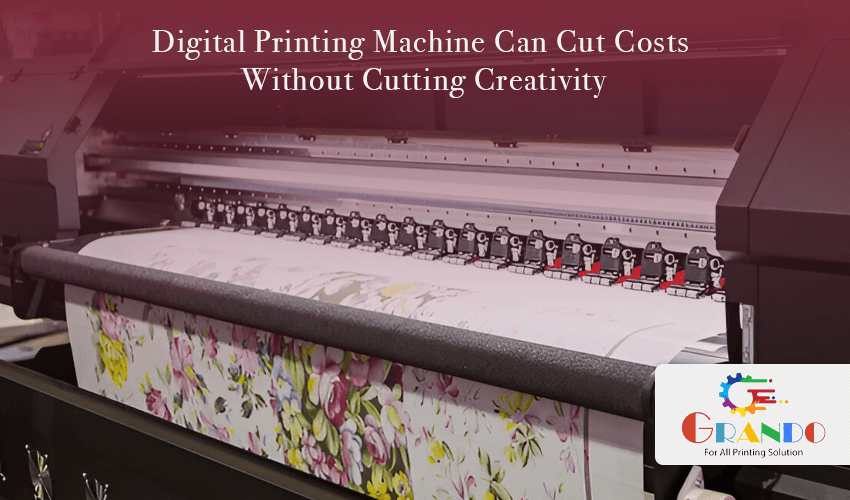
What is a Digital Printing Machine?
A digital printing machine is an advanced device that transfers digital files directly onto physical surfaces without the need for printing plates or lengthy setup processes. Unlike traditional printing, it supports a wide range of materials, including paper, fabric, plastic, metal, and wood. Discover more about the digital printing machine.”
This technology is highly flexible, making it ideal for small businesses, creative professionals, and large-scale manufacturers. It allows for cost-effective, short-run printing and fast turnaround times, making it efficient for both customized and lower-volume production needs.
Types of Digital Printing Machines:
Inkjet Printers: Masters of rich color and high-resolution images. Perfect for those eye-catching, photo-heavy jobs.
Laser Printers: Fast, sharp, and fantastic for clean text and bold graphics.
UV Printers: These bad boys can print on just about anything—including glass, metal, and acrylic. The ink dries instantly under UV light.
Textile Printers: Specialised for fabrics—ideal for fashion lines, home décor, and personalised merch.
Top Industries Using Digital Printing
- Fashion & Apparel
The fashion world thrives on fast trends and unique styles. Digital textile printing makes testing new designs easy, offering limited-edition runs, and avoiding excess inventory.
- Marketing & Advertising
From flyers to banners, digital printing allows agencies to test multiple designs, target different demographics, and customise content—all without ballooning the budget.
- Packaging
Custom boxes and labels no longer require massive orders. Digital printing supports agile, branded packaging that can change with seasons, promos, or campaigns.
- Art & Photography
Artists can sell prints affordably without bulk orders. Photographers can offer gallery-quality reproductions without investing in massive print runs.
- Interior Design
From bespoke wallpaper to personalized canvas prints, designers can bring unique visions to life without high costs or logistical nightmares.
Cost Comparison: Digital VS. Traditional Printing
| Feature | Digital Printing | Traditional Printing |
| Setup Cost | Low | High (plates, setup time) |
| Best for | Short runs, customization | Large volumes |
| Turnaround Time | Fast | Slower |
| Design Flexibility | Very High | Low |
| Waste | Minimal | Often high |
| Per Unit Cost (Small Runs) | Low | High |
Digital Printing and Sustainability
Digital printing doesn’t just save you money—it’s also way better for the planet.
- Less Waste: Only print what’s needed = less trash.
- Eco-Friendly Inks: Many digital printers use water-based or UV-curable inks, which are more environmentally friendly than traditional solvent-based ones.
- Fewer Chemicals: No plates mean no chemical processing, which reduces pollution and hazards.
- Lower Energy Use: Modern digital machines are more energy-efficient, especially for short print runs.
Eco-Friendly Advantages
- Less Waste: Only print what you need.
- Greener Inks: Many machines use eco-friendly, water-based, or UV-curable inks.
- Fewer Chemicals: No need for harmful plate development chemicals.
- Lower Power Usage: Especially for short, frequent jobs, digital printing consumes less energy.
Future Trends in Digital Printing
The future is looking bold and brilliant. Here’s what’s coming next:
- AI-Enhanced Printing: Machines that auto-correct color and layout for flawless results.
- 3D Printing Integration: Combine digital printing with dimensional design for incredible prototypes and packaging.
- AR Packaging: Turn printed materials into digital experiences—just scan with your phone.
- Hyper-Personalization: Every product can tell its own story. Digital printing makes mass personalization finally scalable.
FAQ:
Q: What materials will you print on?
Ans: Not every printer works on every surface. Choose one that suits your needs—paper, fabric, plastic, metal, etc.
Q: I change designs often. Is digital printing a good fit?
Ans: Absolutely. It’s designed for frequent design updates, and quick file swaps mean zero delays and no retooling.
Q: Are all digital printers eco-friendly?
Ans: Most modern ones are, especially models using eco-solvent or water-based inks. Check specs before you buy.
Q: What’s a decent budget for getting started?
Ans: Digital printers come in all shapes and sizes. Entry-level models might start at a few hundred bucks, while commercial-grade machines can climb into the tens of thousands. Pick based on your needs and how often you’ll print.
